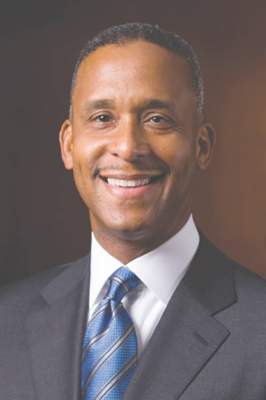User login
The American College of Physicians is hoping the recent heightened focus on rising prescription drug costs will strengthen the political will to act on a number of policy recommendations that have failed to gain significant traction in recent years.
“We think the times are different,” Dr. Wayne J. Riley, ACP president, said in an interview. “The tenor of the times based on the Congressional hearings over the rise in new drug costs has really highlighted the fact that Americans are struggling with the rising costs of prescription drugs.”
The college highlighted a number of proposals in a position paper, including greater price transparency; eliminating the ban on use of quality-adjusted life-years as a comparative effectiveness measure in research conducted by the Patient-Centered Outcomes Research Institute; eliminating the ban on Medicare’s ability to negotiate on drug pricing; allowing the reimportation of drugs manufactured in the United States; limitations and improved oversight on patent exclusivity; and more oversight of drug formularies to ensure tiering and restrictions are not creating an economic barrier to access.
The position paper was published online March 29 in Annals of Internal Medicine (2016. doi: 10.7326/M15-2768).
“We are getting a lot of interest from congressional staffs asking us, what are our position and recommendations? What should Congress be thinking about specifically to work on the prescription drug issue?” Dr. Riley said. “The paper does call for what we think are very reasonable approaches.”
He added that members of Congress seem receptive to giving Medicare price negotiation power, something that has failed to gain any traction since the ban was put in place in the Medicare Modernization Act of 2003.
Dr. Riley said that if he were to narrow down the recommendations to one or two key items to focus on, Medicare negotiations would be one and allowing reimportation of drugs manufactured in the United States another.
He also stressed that ACP is focused on fostering ways to gather better data on value. “What is the value of the drug for the cost and price that our patients are paying?”
Dr. William Golden of University of Arkansas for Medical Sciences, Little Rock, was a bit more reserved on whether the political will is strengthening to turn any of these recommendations into legislative action.
“Politics is always a maybe,” he said, “but the price of insulin has tripled over the last 5 years, the price of generic cholesterol medications has gone from $4 a month to $60 or $70 a month for something as basic as pravastatin. I think that we are seeing an end game, and I think that it’s becoming apparent in the political environment [that] the public opinion polls are becoming increasingly uncomfortable with the trend lines.”
“That’s the key issue, that the current pricing structure is not sustainable,” he said.
The American College of Physicians is hoping the recent heightened focus on rising prescription drug costs will strengthen the political will to act on a number of policy recommendations that have failed to gain significant traction in recent years.
“We think the times are different,” Dr. Wayne J. Riley, ACP president, said in an interview. “The tenor of the times based on the Congressional hearings over the rise in new drug costs has really highlighted the fact that Americans are struggling with the rising costs of prescription drugs.”
The college highlighted a number of proposals in a position paper, including greater price transparency; eliminating the ban on use of quality-adjusted life-years as a comparative effectiveness measure in research conducted by the Patient-Centered Outcomes Research Institute; eliminating the ban on Medicare’s ability to negotiate on drug pricing; allowing the reimportation of drugs manufactured in the United States; limitations and improved oversight on patent exclusivity; and more oversight of drug formularies to ensure tiering and restrictions are not creating an economic barrier to access.
The position paper was published online March 29 in Annals of Internal Medicine (2016. doi: 10.7326/M15-2768).
“We are getting a lot of interest from congressional staffs asking us, what are our position and recommendations? What should Congress be thinking about specifically to work on the prescription drug issue?” Dr. Riley said. “The paper does call for what we think are very reasonable approaches.”
He added that members of Congress seem receptive to giving Medicare price negotiation power, something that has failed to gain any traction since the ban was put in place in the Medicare Modernization Act of 2003.
Dr. Riley said that if he were to narrow down the recommendations to one or two key items to focus on, Medicare negotiations would be one and allowing reimportation of drugs manufactured in the United States another.
He also stressed that ACP is focused on fostering ways to gather better data on value. “What is the value of the drug for the cost and price that our patients are paying?”
Dr. William Golden of University of Arkansas for Medical Sciences, Little Rock, was a bit more reserved on whether the political will is strengthening to turn any of these recommendations into legislative action.
“Politics is always a maybe,” he said, “but the price of insulin has tripled over the last 5 years, the price of generic cholesterol medications has gone from $4 a month to $60 or $70 a month for something as basic as pravastatin. I think that we are seeing an end game, and I think that it’s becoming apparent in the political environment [that] the public opinion polls are becoming increasingly uncomfortable with the trend lines.”
“That’s the key issue, that the current pricing structure is not sustainable,” he said.
The American College of Physicians is hoping the recent heightened focus on rising prescription drug costs will strengthen the political will to act on a number of policy recommendations that have failed to gain significant traction in recent years.
“We think the times are different,” Dr. Wayne J. Riley, ACP president, said in an interview. “The tenor of the times based on the Congressional hearings over the rise in new drug costs has really highlighted the fact that Americans are struggling with the rising costs of prescription drugs.”
The college highlighted a number of proposals in a position paper, including greater price transparency; eliminating the ban on use of quality-adjusted life-years as a comparative effectiveness measure in research conducted by the Patient-Centered Outcomes Research Institute; eliminating the ban on Medicare’s ability to negotiate on drug pricing; allowing the reimportation of drugs manufactured in the United States; limitations and improved oversight on patent exclusivity; and more oversight of drug formularies to ensure tiering and restrictions are not creating an economic barrier to access.
The position paper was published online March 29 in Annals of Internal Medicine (2016. doi: 10.7326/M15-2768).
“We are getting a lot of interest from congressional staffs asking us, what are our position and recommendations? What should Congress be thinking about specifically to work on the prescription drug issue?” Dr. Riley said. “The paper does call for what we think are very reasonable approaches.”
He added that members of Congress seem receptive to giving Medicare price negotiation power, something that has failed to gain any traction since the ban was put in place in the Medicare Modernization Act of 2003.
Dr. Riley said that if he were to narrow down the recommendations to one or two key items to focus on, Medicare negotiations would be one and allowing reimportation of drugs manufactured in the United States another.
He also stressed that ACP is focused on fostering ways to gather better data on value. “What is the value of the drug for the cost and price that our patients are paying?”
Dr. William Golden of University of Arkansas for Medical Sciences, Little Rock, was a bit more reserved on whether the political will is strengthening to turn any of these recommendations into legislative action.
“Politics is always a maybe,” he said, “but the price of insulin has tripled over the last 5 years, the price of generic cholesterol medications has gone from $4 a month to $60 or $70 a month for something as basic as pravastatin. I think that we are seeing an end game, and I think that it’s becoming apparent in the political environment [that] the public opinion polls are becoming increasingly uncomfortable with the trend lines.”
“That’s the key issue, that the current pricing structure is not sustainable,” he said.
FROM ANNALS OF INTERNAL MEDICINE



